A Framework to Understand Attitudes towards Immigration through Twitter
Abstract
:1. Introduction
2. Background
2.1. Theories and Measurement of Attitude Formation
2.2. Social Media Analysis in the Study of Human Behaviour
2.3. Immigration in Chile
3. Dataset
4. Methodology
4.1. Theory-Informed Profile Labelling
4.2. Attitude Classification and Propagation
- A content-term matrix, where each row represents user i, and each term j can represent a word, hashtag, username, URL or emoji. Thus, a cell contains the number of times user i has used the term j in their tweets.
- A profile-term matrix, analogous to the previous one, but this time for the terms contained in the full name and biographical self-description of each user.
- A profile-domain matrix, mapping to each user’s home page its main domain (e.g., twitter.com) and their main top level domain (e.g., .com).
- Since homophily may vary or be absent in different interaction layers [72], we consider the three types of interaction separately. Thus, we build three adjacency matrices based on the interactions in the discussion: retweets, replies, and quotes. Each matrix stores in a cell , the number of times user i has interacted with user j (for instance, if i retweets j one time, ).
- A user–attitude interaction matrix for each type of interaction, where each cell contains the number of times the corresponding user has interacted with other users that were labelled with an attitude.
4.3. Attitude Characterisation
4.3.1. Content Characterisation
4.3.2. Psycholinguistic Characterisation
- Standard linguistic processes: articles, prepositions, pronouns, etc.
- Psychological and affective processes: positive and negative emotions, with subcategories such as anger and anxiety.
- Relativity: time, verb tense, motion, space.
- Personal matters: sex, death, home, occupation, etc.
4.3.3. Dynamics and Events
5. Results
5.1. Attitude Identification and Classification
5.2. Content Characterisation
5.3. Psycholinguistic Characterisation
5.4. Dynamics and Events
- 19/04: The Chilean Census was carried out. Tweets regarding foreign interviewers went viral (positive trend spike).
- 01/07: The National Institute of Human Rights filed a complaint against a migrant trafficking gang (positive trend spike).
- 06/09: The Minister of Home Affairs, Mario Fernández, faced an appeal at the National Congress after a delay in the Migration Law (negative trend spike).
- 19/09: A sign was installed in Talca (a city on central Chile) urging Haitians to join the Communist Party (negative trend spike).
- 01/11: Director of the Central Public Hospital declared that Joane Florvil (Haitian woman who died after being arrested by Chilean police) had been beaten at the police station (positive trend spike).
- 15/11: Senator Fulvio Rossi from Antofagasta (a city in northern Chile) was stabbed. He stated that “the attacker had a foreign accent and would be a black person” (negative trend spike).
- 18/11: Haitian immigrants attacked police in a commercial neighbourhood in downtown Santiago (negative trend spike).
- 22/11: (1) The Court declared the posthumous innocence of Joane Florvil. (2) Michelle Bachelet recognised not only the heroic act of Richard Joseph (Haitian citizen who rescued a woman who fell from a building) but also a set of positive human values in migration (positive trend spike).
6. Discussion
6.1. Key Results
6.2. Interpretation
6.3. Limitations and Future Work
7. Conclusions
Author Contributions
Funding
Institutional Review Board Statement
Informed Consent Statement
Data Availability Statement
Conflicts of Interest
Abbreviations
| API | application programming interface |
| ICT | intergroup contact theory |
| ITT | integrated threat theory |
| LIWC | linguistic inquiry and word count |
| RQ | research question |
| RTs | retweets |
| TF-IDF | term frequency—inverse document frequency |
| UK | United Kingdom |
References
- European Political Strategy Centre. European Commission. 10 Trends Shaping Migration. Available online: https://op.europa.eu/s/oq7V (accessed on 16 September 2021).
- Bail, C.A.; Argyle, L.P.; Brown, T.W.; Bumpus, J.P.; Chen, H.; Hunzaker, M.F.; Lee, J.; Mann, M.; Merhout, F.; Volfovsky, A. Exposure to opposing views on social media can increase political polarization. Proc. Natl. Acad. Sci. USA 2018, 115, 9216–9221. [Google Scholar] [CrossRef] [PubMed] [Green Version]
- Greven, T. The Rise of Right-Wing Populism in Europe and the United States. A Comparative Perspective [La Emergencia del Populismo de Derechas en Europa y Estados Unidos. Una Perspectiva Comparada]; Friedrich Ebert Foundation: Washington, DC, USA, 2016; pp. 1–8. [Google Scholar]
- Dennison, J.; Geddes, A. A rising tide? The salience of immigration and the rise of anti-immigration political parties in Western Europe. Political Q. 2019, 90, 107–116. [Google Scholar] [CrossRef] [Green Version]
- Blinder, S.; Allen, W. UK public opinion toward immigration: Overall attitudes and level of concern. In Migration Observatory Briefing, COMPAS; University of Oxford: Oxford, UK, 2016. [Google Scholar]
- Cheong, P.H.; Edwards, R.; Goulbourne, H.; Solomos, J. Immigration, social cohesion and social capital: A critical review. Crit. Soc. Policy 2007, 27, 24–49. [Google Scholar] [CrossRef]
- Penninx, R.; Spencer, D.; Van Hear, N. Migration and Integration in Europe: The State of Research; Economic and Social Research Council: Swindon, UK, 2008. [Google Scholar]
- United Nations. Sustainable Development Goals. Available online: https://www.un.org/sustainabledevelopment/sustainable-development-goals/ (accessed on 16 September 2021).
- Global Compact for Migration. Global Compact for Safe, Orderly and Regular Migration. Available online: https://refugeesmigrants.un.org/sites/default/files/180713_agreed_outcome_global_compact_for_migration.pdf (accessed on 16 September 2021).
- Rowe, F.; Mahony, M.; Graells-Garrido, E.; Rango, M.; Sievers, N. Using Twitter Data to Monitor Immigration Sentiment. Practitioners’ Guidebook; International Organization for Migration; United Nations: Berlin, Germany, 2021. [Google Scholar]
- Grigorieff, A.; Roth, C.; Ubfal, D. Does information change attitudes toward immigrants? Demography 2020, 57, 1117–1143. [Google Scholar] [CrossRef]
- Dennison, J.; Dražanová, L. Public Attitudes on Migration: Rethinking How People Perceive Migration: An Analysis of Existing Opinion Polls in the Euro-Mediterranean Region; Technical Report; European University Institute: Fiesole, Italy, 2018. [Google Scholar]
- Burns, P.; Gimpel, J.G. Economic insecurity, prejudicial stereotypes, and public opinion on immigration policy. Political Sci. Q. 2000, 115, 201–225. [Google Scholar] [CrossRef]
- Rowe, F.; Mahony, M.; Graells-Garrido, E.; Rango, M.; Sievers, N. Using Twitter to track immigration sentiment during early stages of the COVID-19 pandemic. SocArXiv 2021. [Google Scholar] [CrossRef]
- Wu, S.; Hofman, J.M.; Mason, W.A.; Watts, D.J. Who says what to whom on Twitter. In Proceedings of the 20th International Conference on World Wide Web, Yderabad, India, 28 March–1 April 2011; pp. 705–714. [Google Scholar]
- Garimella, K.; De Francisci Morales, G.; Gionis, A.; Mathioudakis, M. The effect of collective attention on controversial debates on social media. In Proceedings of the 2017 ACM on Web Science Conference, Troy, NY, USA, 25–28 June 2017; pp. 43–52. [Google Scholar]
- Graells-Garrido, E.; Baeza-Yates, R.; Lalmas, M. Every colour you are: Stance prediction and turnaround in controversial issues. In Proceedings of the 12th ACM Conference on Web Science, Southampton, UK, 6–10 July 2020; Association for Computing Machinery: New York, NY, USA, 2020; pp. 174–183. [Google Scholar] [CrossRef]
- Bosco, C.; Patti, V.; Bogetti, M.; Conoscenti, M.; Ruffo, G.F.; Schifanella, R.; Stranisci, M. Tools and Resources for Detecting Hate and Prejudice against Immigrants in Social Media. Symposium III. Social Interactions in Complex Intelligent Systems (SICIS). Artificial Intelligence and Simulation of Behaviour (AISB). 2017, pp. 79–84. Available online: https://iris.unito.it/retrieve/handle/2318/1637776/332903/paperBATH.pdf (accessed on 16 September 2021).
- Sanguinetti, M.; Poletto, F.; Bosco, C.; Patti, V.; Stranisci, M. An Italian Twitter Corpus of Hate Speech against Immigrants. In Proceedings of the Eleventh International Conference on Language Resources and Evaluation (LREC 2018), Miyazaki, Japan, 7–12 May 2018; Available online: https://www.aclweb.org/anthology/L18-1443 (accessed on 16 September 2021).
- Basile, V.; Bosco, C.; Fersini, E.; Debora, N.; Patti, V.; Pardo, F.M.R.; Rosso, P.; Sanguinetti, M. Semeval-2019 task 5: Multilingual detection of hate speech against immigrants and women in Twitter. In Proceedings of the 13th International Workshop on Semantic Evaluation. Association for Computational Linguistics, Minneapolis, MN, USA, 6–7 June 2019; pp. 54–63. Available online: https://arxiv.org/abs/2011.13238 (accessed on 16 September 2021).
- Comandini, G.; Patti, V. An Impossible Dialogue! Nominal Utterances and Populist Rhetoric in an Italian Twitter Corpus of Hate Speech against Immigrants. In Proceedings of the Third Workshop on Abusive Language Online, Florence, Italy, 1 August 2019; pp. 163–171. Available online: https://www.aclweb.org/anthology/W19-3518/ (accessed on 16 September 2021).
- Calderón, C.A.; de la Vega, G.; Herrero, D.B. Topic modeling and characterization of hate speech against immigrants on Twitter around the emergence of a far-right party in Spain. Soc. Sci. 2020, 9, 188. [Google Scholar] [CrossRef]
- Porcher, S.; Renault, T. Social distancing beliefs and human mobility: Evidence from Twitter. PLoS ONE 2021, 16, e0246949. [Google Scholar] [CrossRef]
- Waseem, Z.; Hovy, D. Hateful Symbols or Hateful People? Predictive Features for Hate Speech Detection on Twitter. In Proceedings of the NAACL Student Research Workshop, San Diego, CA, USA, 12–17 June 2016; pp. 88–93. [Google Scholar] [CrossRef]
- Bovet, A.; Makse, H.A. Influence of fake news in Twitter during the 2016 US presidential election. Nat. Commun. 2019, 10, 7. [Google Scholar] [CrossRef]
- Grinberg, N.; Joseph, K.; Friedland, L.; Swire-Thompson, B.; Lazer, D. Fake news on Twitter during the 2016 US presidential election. Science 2019, 363, 374–378. [Google Scholar] [CrossRef]
- Rowe, F.; Darlington-Pollock, F. Quantifying and Understanding the Extent of Residential Segregation of Recent Immigrants in Chile; Conference Paper; The British Society for Population Studies: Cardiff, UK, 2019. [Google Scholar]
- Allport, G.W.; Clark, K.; Pettigrew, T. The Nature of Prejudice; Addison-Wesley Reading: Boston, MA, USA, 1954. [Google Scholar]
- Nelson, T.D. Handbook of Prejudice, Stereotyping, and Discrimination; Psychology Press: Hove, UK, 2009. [Google Scholar]
- Stephan, W.G.; Stephan, C.W. An integrated threat theory of prejudice. Reducing Prejudice and Discrimination; Psychology Press: Hove, UK, 2000; pp. 23–45. [Google Scholar]
- Paluck, E.L.; Green, S.A.; Green, D.P. The contact hypothesis re-evaluated. Behav. Public Policy 2019, 3, 129–158. [Google Scholar] [CrossRef] [Green Version]
- Pettigrew, T.F.; Tropp, L.R. How does intergroup contact reduce prejudice? Meta-analytic tests of three mediators. Eur. J. Soc. Psychol. 2008, 38, 922–934. [Google Scholar] [CrossRef]
- Pettigrew, T.F.; Tropp, L.R. A meta-analytic test of intergroup contact theory. J. Personal. Soc. Psychol. 2006, 90, 751. [Google Scholar] [CrossRef] [PubMed] [Green Version]
- Barlow, F.K.; Louis, W.R.; Hewstone, M. Rejected! Cognitions of rejection and intergroup anxiety as mediators of the impact of cross-group friendships on prejudice. Br. J. Soc. Psychol. 2009, 48, 389–405. [Google Scholar] [CrossRef]
- Stephan, W.G.; Stephan, C.W. Intergroup anxiety. J. Soc. Issues 1985, 41, 157–175. [Google Scholar] [CrossRef]
- Bertrand, M.; Duflo, E. Field experiments on discrimination. Handb. Econ. Field Exp. 2017, 1, 309–393. [Google Scholar]
- Stephan, W.G.; Finlay, K. The role of empathy in improving intergroup relations. J. Soc. Issues 1999, 55, 729–743. [Google Scholar] [CrossRef]
- Esses, V.M.; Dovidio, J.F.; Jackson, L.M.; Armstrong, T.L. The immigration dilemma: The role of perceived group competition, ethnic prejudice, and national identity. J. Soc. Issues 2001, 57, 389–412. [Google Scholar] [CrossRef]
- Ha, S.E. The consequences of multiracial contexts on public attitudes toward immigration. Political Res. Q. 2010, 63, 29–42. [Google Scholar] [CrossRef]
- Hanson, G.H.; Scheve, K.; Slaughter, M.J. Public finance and individual preferences over globalization strategies. Econ. Politics 2007, 19, 1–33. [Google Scholar] [CrossRef]
- International Organization for Migration (OIM). DATA BULLETIN SERIES. Informing the Implementation of the Global Compact for Migration. Available online: https://publications.iom.int/system/files/pdf/gmdacbulletins.pdf (accessed on 16 September 2021).
- Sylwester, K.; Purver, M. Twitter language use reflects psychological differences between democrats and republicans. PLoS ONE 2015, 10, e0137422. [Google Scholar]
- Golder, S.A.; Macy, M.W. Diurnal and seasonal mood vary with work, sleep, and daylength across diverse cultures. Science 2011, 333, 1878–1881. [Google Scholar] [CrossRef] [Green Version]
- Ritter, R.S.; Preston, J.L.; Hernandez, I. Happy tweets: Christians are happier, more socially connected, and less analytical than atheists on Twitter. Soc. Psychol. Personal. Sci. 2014, 5, 243–249. [Google Scholar] [CrossRef]
- Conover, M.D.; Ratkiewicz, J.; Francisco, M.; Gonçalves, B.; Menczer, F.; Flammini, A. Political polarization on Twitter. In Proceedings of the Fifth International AAAI Conference on Weblogs and Social Media, Barcelona, Catalonia, Spain, 17–21 July 2011. [Google Scholar]
- Garcia-Gavilanes, R.; Quercia, D.; Jaimes, A. Cultural dimensions in Twitter: Time, Individualism and Power. In Proceedings of the Seventh International AAAI Conference on Weblogs and Social Media, Cambridge, MA, USA, 8–11 July 2013. [Google Scholar]
- Darwish, K.; Magdy, W.; Rahimi, A.; Baldwin, T.; Abokhodair, N. Predicting online islamophopic behavior after# parisattacks. J. Web Sci. 2018, 4, 34–52. [Google Scholar]
- Lamanna, F.; Lenormand, M.; Salas-Olmedo, M.H.; Romanillos, G.; Gonçalves, B.; Ramasco, J.J. Immigrant community integration in world cities. PLoS ONE 2018, 13, e0191612. [Google Scholar] [CrossRef] [PubMed]
- Fortuna, P.; Nunes, S. A survey on automatic detection of hate speech in text. ACM Comput. Surv. (CSUR) 2018, 51, 1–30. [Google Scholar] [CrossRef]
- Ribeiro, M.; Calais, P.; Santos, Y.; Almeida, V.; Meira Jr, W. Characterizing and Detecting Hateful Users on Twitter. In Proceedings of the International AAAI Conference on Web and Social Media, Stanford, CA, USA, 25–28 June 2018; Volume 12. Available online: https://arxiv.org/abs/1803.08977v1 (accessed on 16 September 2021).
- Zhang, Q.; Liang, S.; Lipani, A.; Ren, Z.; Yilmaz, E. From Stances’ Imbalance to Their Hierarchical Representation and Detection. In Proceedings of the The World Wide Web Conference, San Francisco, CA, USA, 13–17 May 2019; pp. 2323–2332. [Google Scholar] [CrossRef] [Green Version]
- Garimella, K.; De Francisci Morales, G.; Gionis, A.; Mathioudakis, M. Political discourse on social media: Echo chambers, gatekeepers, and the price of bipartisanship. In Proceedings of the 2018 World Wide Web Conference on World Wide Web, Lyon, France, 23–27 April 2018; International World Wide Web Conferences Steering Committee: Lyon, France, 2018; pp. 913–922. [Google Scholar]
- Garimella, K.; Morales, G.D.F.; Gionis, A.; Mathioudakis, M. Quantifying controversy on social media. ACM Trans. Soc. Comput. 2018, 1, 3. [Google Scholar] [CrossRef] [Green Version]
- Conover, M.D.; Gonçalves, B.; Ratkiewicz, J.; Flammini, A.; Menczer, F. Predicting the political alignment of Twitter users. In Proceedings of the 2011 IEEE Third International Conference on Privacy, Security, Risk and Trust (PASSAT) and 2011 IEEE Third International Conference on Social Computing (SocialCom), Boston, MA, USA, 9–11 October 2011; IEEE: Boston, MA, USA, 2011; pp. 192–199. [Google Scholar]
- Lu, H.; Caverlee, J.; Niu, W. Biaswatch: A lightweight system for discovering and tracking topic-sensitive opinion bias in social media. In Proceedings of the 24th ACM International on Conference on Information and Knowledge Management, Melbourne, Australia, 19–23 October 2015; ACM: Melbourne, Australia, 2015; pp. 213–222. [Google Scholar]
- Wilson, T.; Wiebe, J.; Hoffmann, P. Recognizing contextual polarity in phrase-level sentiment analysis. In Proceedings of the Human Language Technology Conference and Conference on Empirical Methods in Natural Language Processing, Vancouver, BC, Canada, 6–8 October 2005; pp. 347–354. [Google Scholar]
- Pang, B.; Lee, L. Opinion Mining and Sentiment Analysis; Association for Computing Machinery: New York, NY, USA, 2008; Volume 2, pp. 1–135. [Google Scholar] [CrossRef] [Green Version]
- Pennebaker, J.W.; Mehl, M.R.; Niederhoffer, K.G. Psychological aspects of natural language use: Our words, our selves. Annu. Rev. Psychol. 2003, 54, 547–577. [Google Scholar] [CrossRef] [Green Version]
- De Choudhury, M.; Counts, S.; Horvitz, E.J.; Hoff, A. Characterizing and predicting postpartum depression from shared Facebook data. In Proceedings of the 17th ACM Conference on Computer Supported CooperativeWork & Social Computing, Baltimore, MA, USA, 15–19 February 2014; pp. 626–638. [Google Scholar]
- Harman, G.; Dredze, M.H. Measuring post traumatic stress disorder in Twitter. In Proceedings of the Eighth International AAAI Conference on Weblogs and Social Media (ICWSM), Palo Alto, CA, USA, 1–4 June 2014; Available online: https://www.cs.jhu.edu/~mdredze/publications/2014_icwsm_ptsd.pdf (accessed on 16 September 2021).
- Tumasjan, A.; Sprenger, T.O.; Sandner, P.G.; Welpe, I.M. Predicting elections with Twitter: What 140 characters reveal about political sentiment. In Proceedings of the Fourth International AAAI Conference on Weblogs and Social Media, Washington, DC, USA, 23–26 May 2010. [Google Scholar]
- Vasquez-Henriquez, P.; Graells-Garrido, E.; Caro, D. Tweets on the go: Gender differences in transport perception and its discussion on social media. Sustainability 2020, 12, 5405. [Google Scholar] [CrossRef]
- Ramírez-Esparza, N.; Pennebaker, J.W.; García, F.A.; Suriá, R. La psicología del uso de las palabras: Un programa de computadora que analiza textos en español. Rev. Mex. Psicol. 2007, 24, 85–99. [Google Scholar]
- Economic Commission for Latin America and the Caribbean (ECLAC). Demographic Observatory of Latin America 2018: International Migration. Available online: https://www.oecd.org/acerca/miembros-y-socios/ (accessed on 16 September 2021).
- Dammert, L.; Erlandsen, M. Migración, miedos y medios en la elección presidencial en Chile (2017). Revista CS 2020, 31, 43–76. [Google Scholar] [CrossRef]
- Batarce, C.; La Tercera. Ciudadano haitiano en Valdivia es Sospechoso de Padecer Lepra. Available online: http://www2.latercera.com/noticia/haitiano-se-convierte-primer-caso-lepra-chile-continental/# (accessed on 16 September 2021).
- Public Studies Center. Estudio Nacional de Opinión Pública N∘79, Abril-Mayo 2017. Available online: https://www.cepchile.cl/cep/encuestas-cep/encuestas-2010-2019/estudio-nacional-de-opinion-publica-abril-mayo-2017 (accessed on 16 September 2021).
- Graells-Garrido, E.; Lalmas, M.; Baeza-Yates, R. Encouraging Diversity-and Representation-Awareness in Geographically Centralized Content. In Proceedings of the 21st International Conference on Intelligent User Interfaces, Sonoma, CA, USA, 7–10 March 2016; pp. 7–18. [Google Scholar]
- Bryden, J.; Funk, S.; Jansen, V.A. Word usage mirrors community structure in the online social network Twitter. EPJ Data Sci. 2013, 2, 1–9. [Google Scholar] [CrossRef] [Green Version]
- Nerghes, A.; Lee, J.S. The refugee/migrant crisis dichotomy on Twitter: A network and sentiment perspective. In Proceedings of the 10th ACM Conference on Web Science, Amsterdam, The Netherlands, 27–30 May 2018; pp. 271–280. [Google Scholar]
- Chen, T.; Guestrin, C. Xgboost: A scalable tree boosting system. In Proceedings of the 22nd ACM Sigkdd International Conference on Knowledge Discovery and Data Mining, San Francisco, CA, USA, 13–17 August 2016; pp. 785–794. [Google Scholar]
- Manivannan, A.; Yow, W.Q.; Bouffanais, R.; Barrat, A. Are the different layers of a social network conveying the same information? EPJ Data Sci. 2018, 7, 34. [Google Scholar] [CrossRef]
- Monroe, B.L.; Colaresi, M.P.; Quinn, K.M. Fightin’words: Lexical feature selection and evaluation for identifying the content of political conflict. Political Anal. 2008, 16, 372–403. [Google Scholar] [CrossRef]
- Serrano, M.Á.; Flammini, A.; Menczer, F. Modeling statistical properties of written text. PLoS ONE 2009, 4, e5372. [Google Scholar] [CrossRef] [PubMed] [Green Version]
- Kwak, H.; Lee, C.; Park, H.; Moon, S. What is Twitter, a social network or a news media? In Proceedings of the 19th International Conference on World Wide Web, Raleigh, NC, USA, 26–30 April 2010; pp. 591–600. [Google Scholar]
- Pennebaker, J.W.; Francis, M.E.; Booth, R.J. Linguistic inquiry and word count: LIWC 2001. Mahway Lawrence Erlbaum Assoc. 2001, 71, 2001. [Google Scholar]
- Gallagher, R.J.; Frank, M.R.; Mitchell, L.; Schwartz, A.J.; Reagan, A.J.; Danforth, C.M.; Dodds, P.S. Generalized word shift graphs: A method for visualizing and explaining pairwise comparisons between texts. arXiv 2020, arXiv:2008.02250. [Google Scholar]
- Graells-Garrido, E.; Lalmas, M.; Baeza-Yates, R. Data portraits and intermediary topics: Encouraging exploration of politically diverse profiles. In Proceedings of the 21st International Conference on Intelligent User Interfaces, Sonoma, CA, USA, 7–10 March 2016; pp. 228–240. [Google Scholar]
- Lu, Y.; Zhang, P.; Cao, Y.; Hu, Y.; Guo, L. On the frequency distribution of retweets. Procedia Comput. Sci. 2014, 31, 747–753. [Google Scholar] [CrossRef] [Green Version]
- International Organization for Migration. How the World Views Migration, Geneva. 2015. Available online: https://publications.iom.int/system/files/how_the_world_gallup.pdf (accessed on 16 September 2021).
- Vosoughi, S.; Roy, D.; Aral, S. The spread of true and false news online. Science 2018, 359, 1146–1151. [Google Scholar] [CrossRef]
- Baeza-Yates, R. Bias on the web. Commun. ACM 2018, 61, 54–61. [Google Scholar] [CrossRef]
- Graells-Garrido, E.; Caro, D.; Miranda, O.; Schifanella, R.; Peredo, O.F. The WWW (and an H) of mobile application usage in the city: The what, where, when, and how. In Proceedings of the Companion of the The Web Conference 2018 on The Web Conference 2018, International World Wide Web Conferences Steering Committee, Lyon, France, 23–27 April 2018; pp. 1221–1229. [Google Scholar]
- Graells-Garrido, E.; Lalmas, M. Balancing diversity to counter-measure geographical centralization in microblogging platforms. In Proceedings of the 25th ACM Conference on Hypertext and Social Media, Santiago, Chile, 1–4 September 2014; pp. 231–236. [Google Scholar]
- Graells-Garrido, E.; Baeza-Yates, R.; Lalmas, M. How representative is an abortion debate on Twitter? In Proceedings of the 10th ACM Conference on Web Science, Boston, MA, USA, 30 June–3 July 2019; pp. 133–134. [Google Scholar]
- Kopstein, J.S.; Wittenberg, J. Does familiarity breed contempt? Inter-ethnic contact and support for illiberal parties. J. Politics 2009, 71, 414–428. [Google Scholar] [CrossRef] [Green Version]
- Twitter. Tutorials: Tweet GeospatialMetadata. 2021. Available online: https://developer.twitter.com/en/docs/tutorials/tweet-geo-metadata (accessed on 16 September 2021).
- Grow, A.; Perrotta, D.; Del Fava, E.; Cimentada, J.; Rampazzo, F.; Gil-Clavel, S.; Zagheni, E.; Flores, R.D.; Ventura, I.; Weber, I.; et al. How Reliable Is Facebook’s Advertising Data for Use in Social Science Research? Insights from a Cross-National Online Survey; Technical Report; Max Planck Institute for Demographic Research: Rostock, Germany, 2021. [Google Scholar]
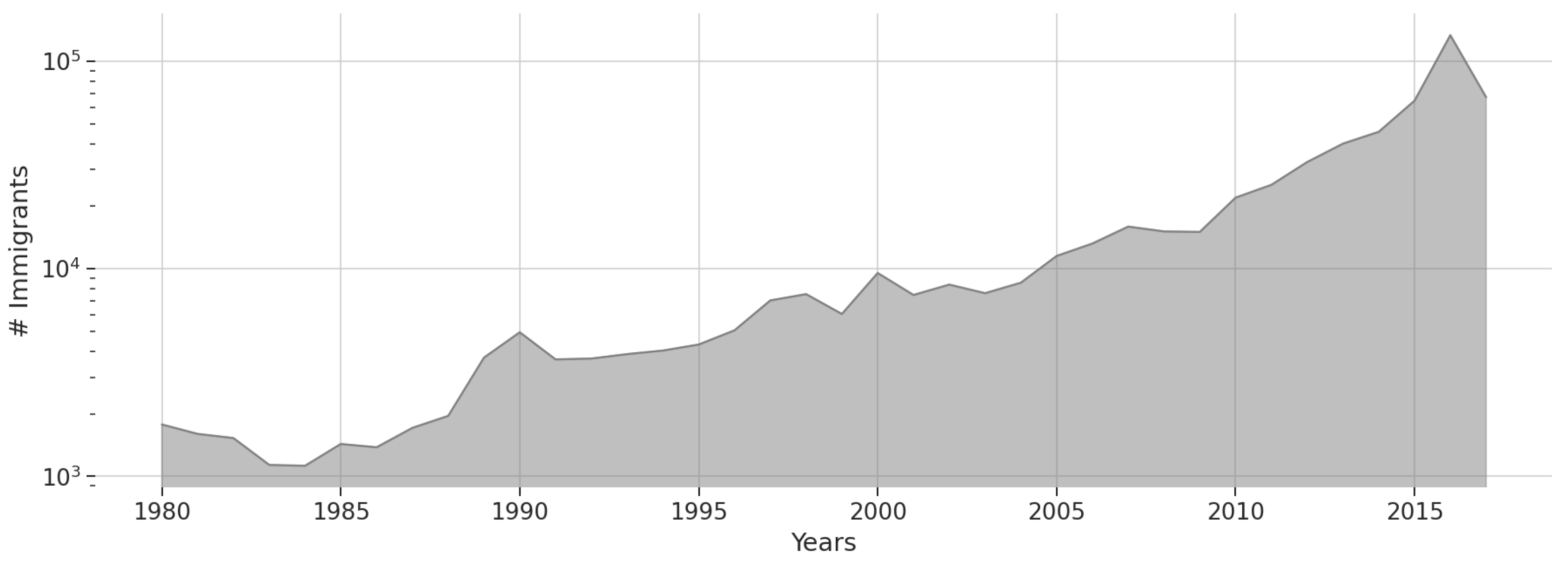
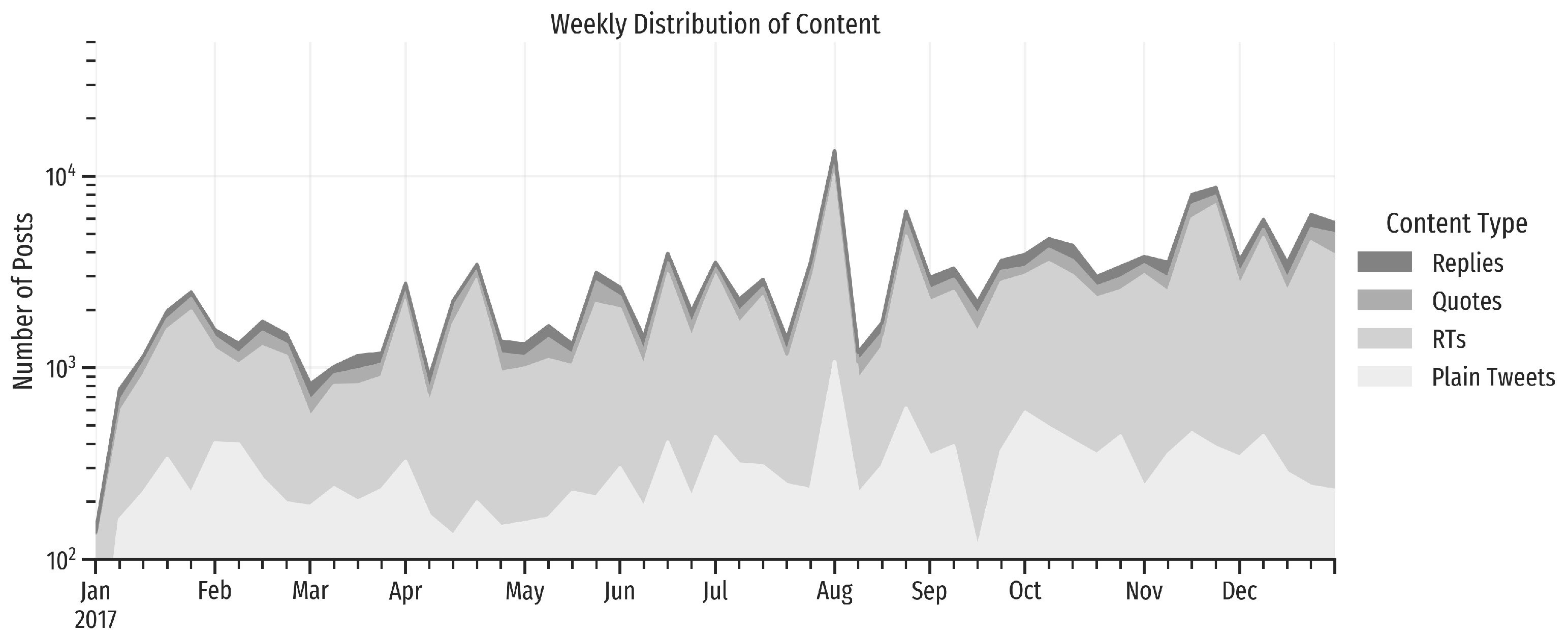
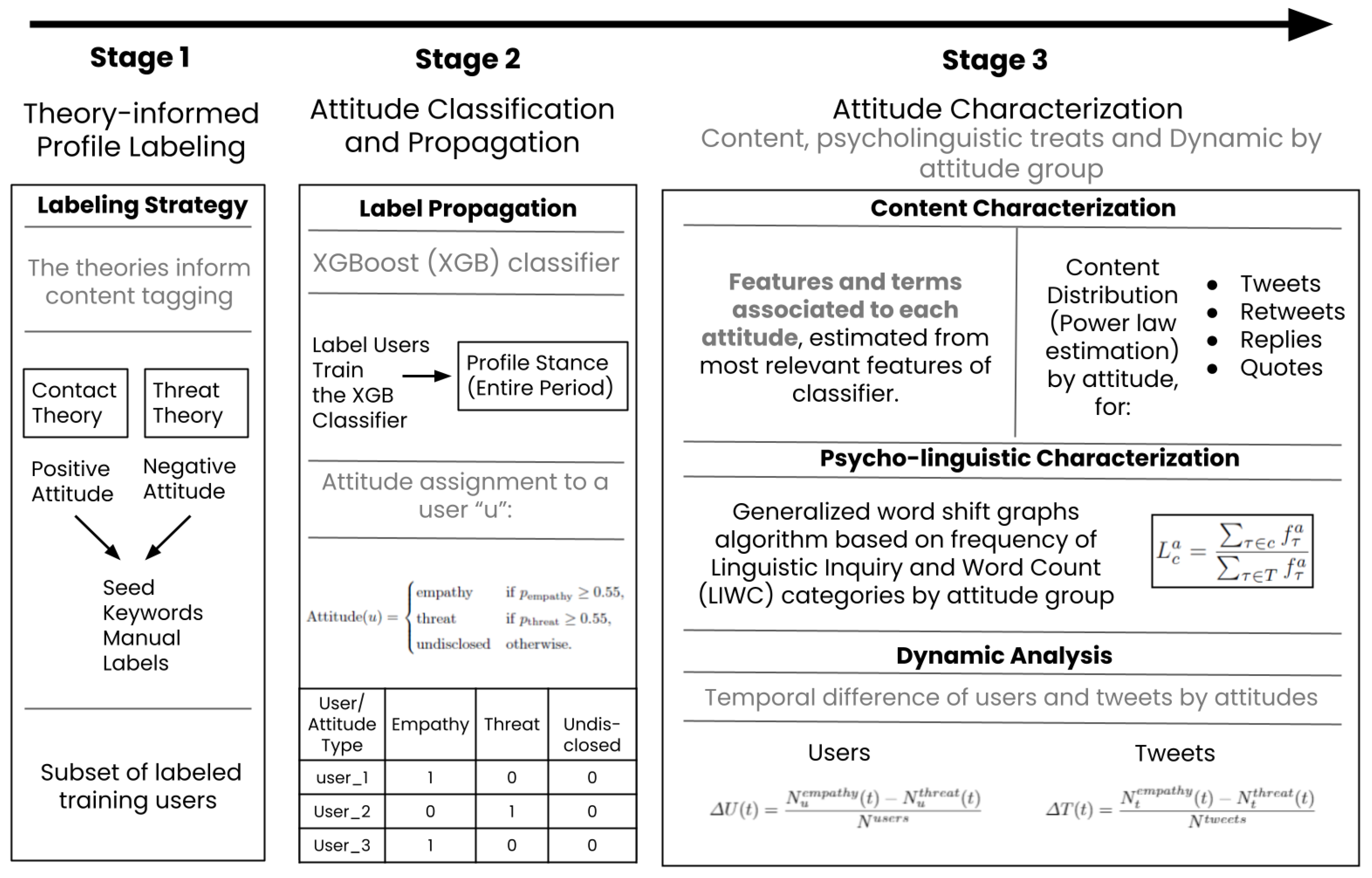
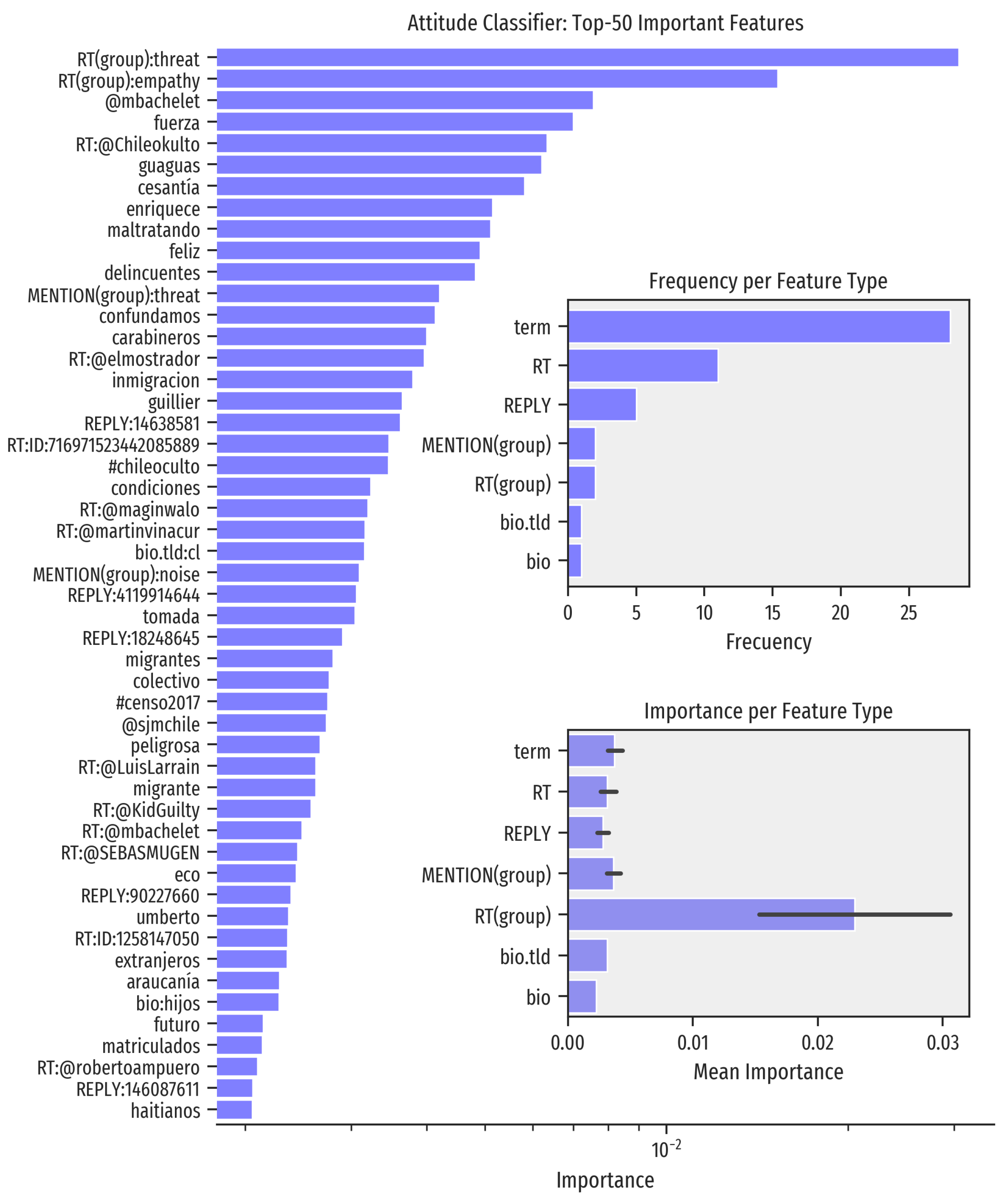
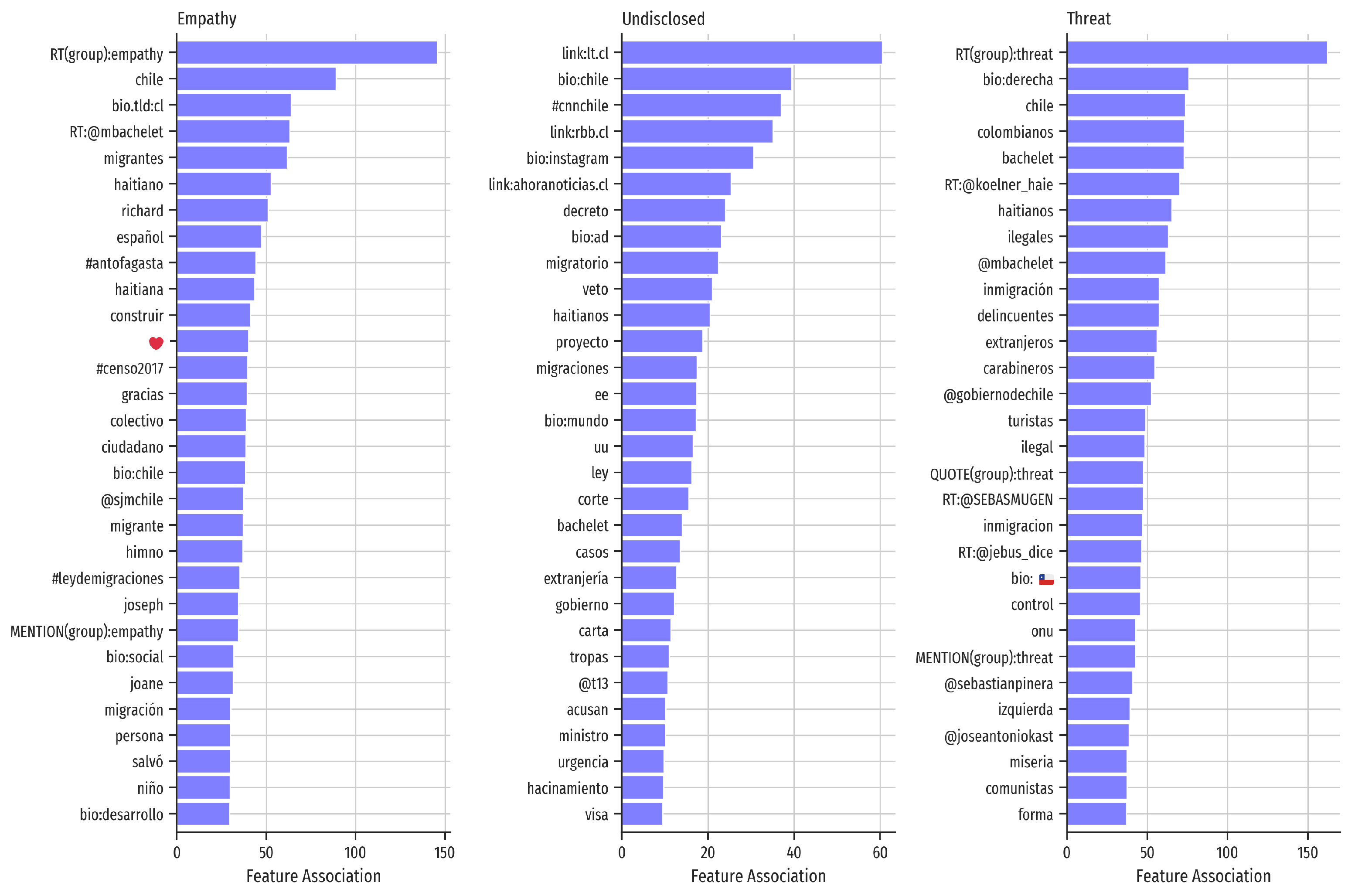
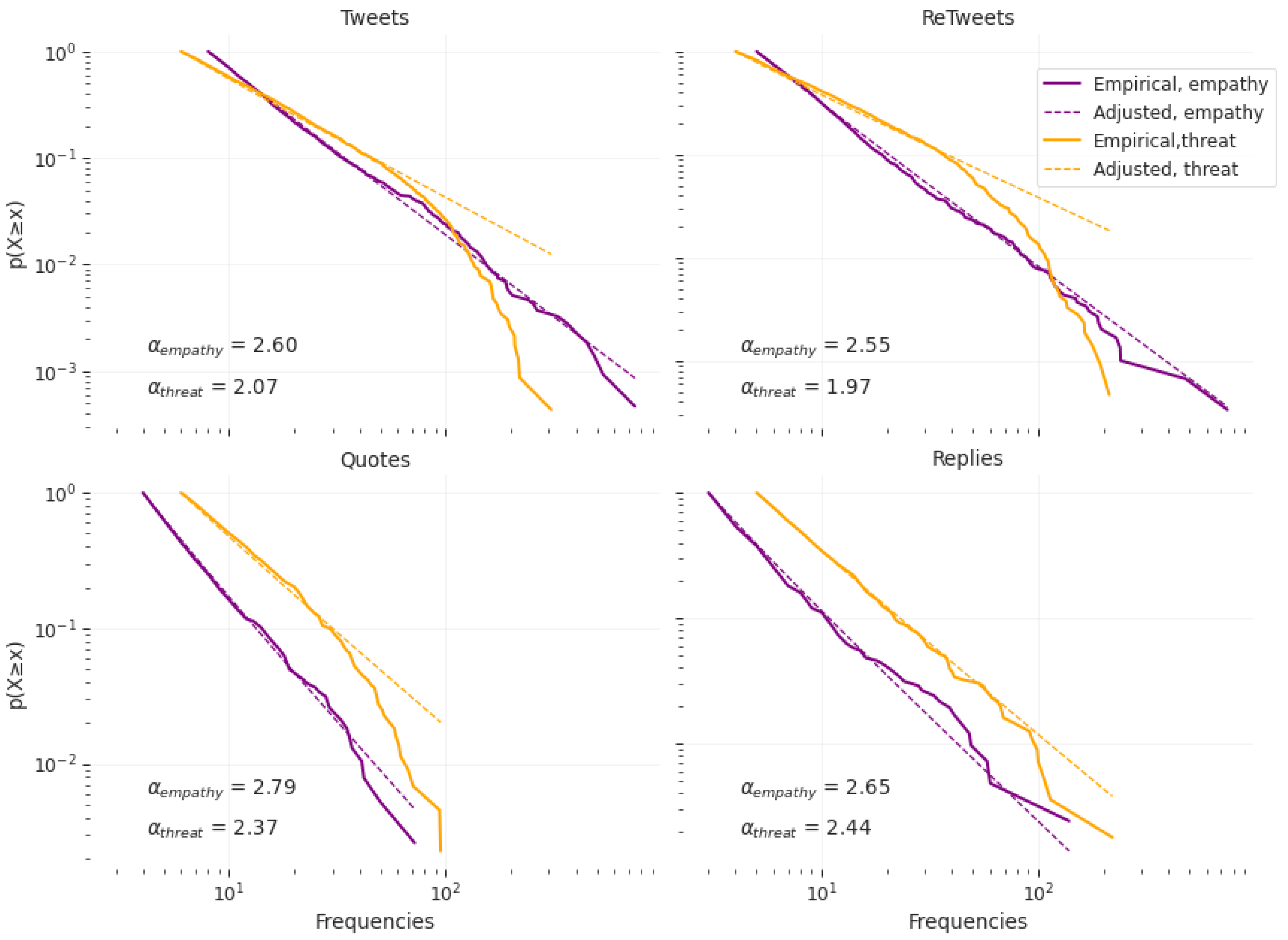
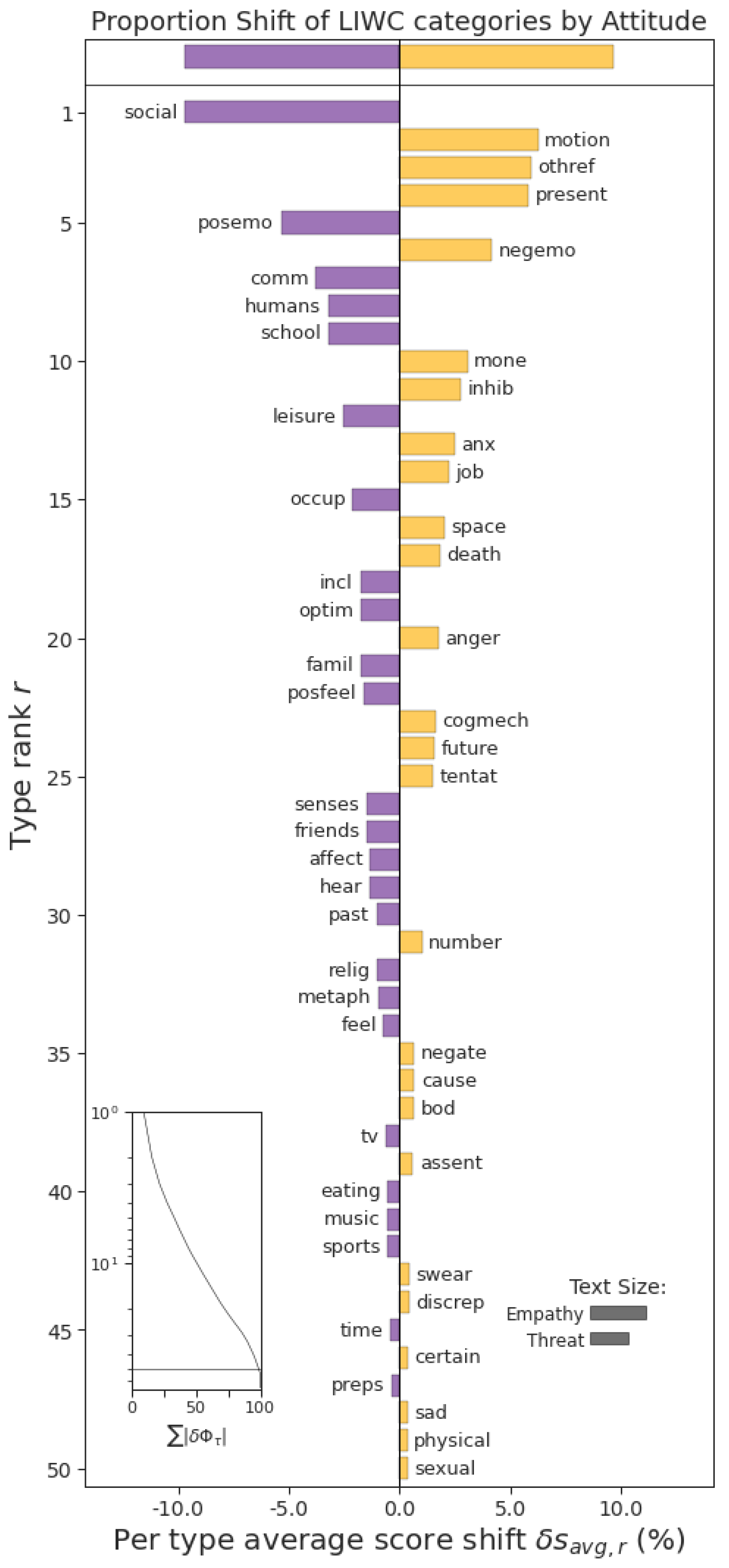
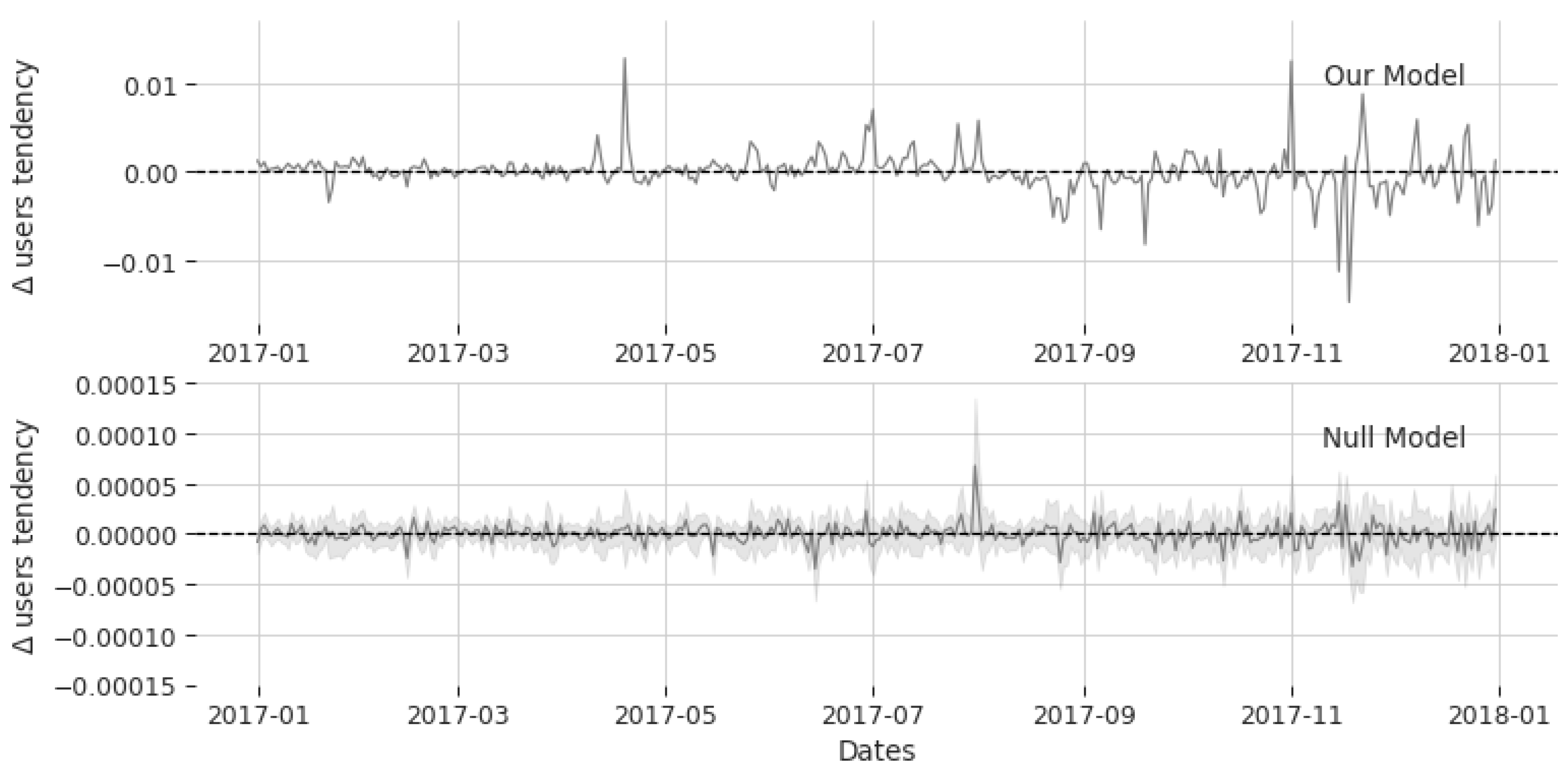
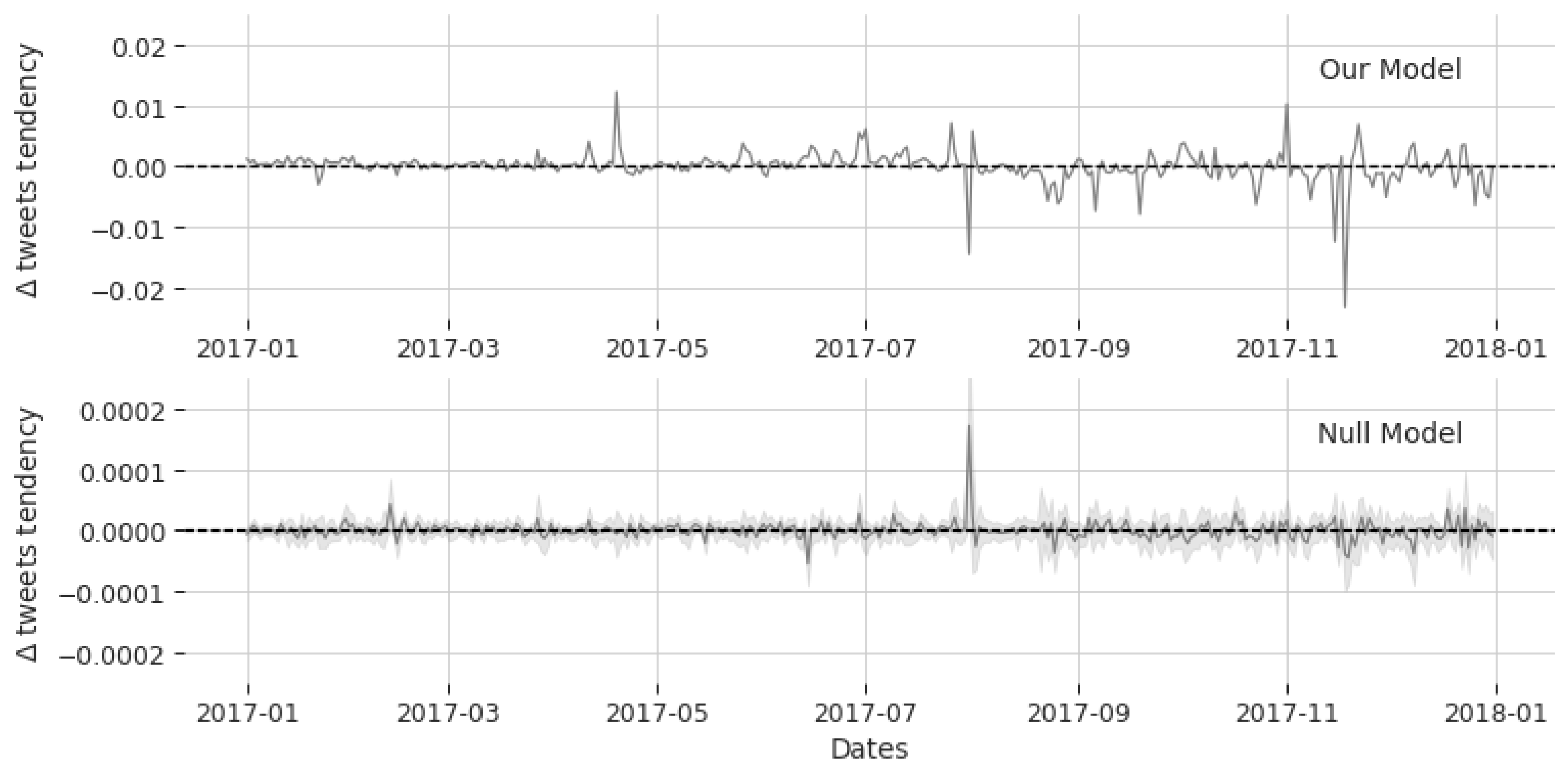
| Attitude | Seed Words and Hashtags (and Their Frequencies in Dataset) |
|---|---|
| Empathy | #bienvenidosachile (welcome to Chile, 26), #chilesinbarreras (Chile without barriers, 7), #chilediverso (Diverse Chile, 43), #noalaxenofobia (no to xenophobia, 126), #nomasxenofobia (no more xenophobia, 30), #racismo (racism, 1336), #stopracismo (stop racism, 48), #nomasracismo(no more racism, 10), #noalracismo (no to racism 73), #pongamonosinmigrantes (let us become immigrants, 67), #todossomoshermanos (we are all siblings, 157), #todossomosmigrantes (we are all migrants, 1108), #bienvenidosmigrantes (welcome migrants, 6), #ningunserhumanoesilegal (no human being is illegal, 16), #nadieesilegal (no one is illegal, 29), #nohayserhumanoilegal (no human being is illegal, 22), #redmigrante (migrant network, 105), #interculturalidad (interculturality, 218), #díadelmigrante (migrant’s day, 269), #sinfronteras (without borders, 371), inhumano (inhuman, 349), multicultural (372), diversidad (diversity, 1531) |
| Threat | #inmigrantesilegales (illegal immigrants, 7), #nomasinmigrantes (no more immigrants, 41), #vendepatria (sells homeland, 5), #estadodecatastrofe (state of catastrophe, 44), invasión (invasion, 1258), invaden (they invade, 62), turba (group of people generating chaos, 732), prestamistas (moneylenders, 372), narcotráfico (drug trafficking, 531), turistas (tourists, 2186), fronterizo (at the border, 292), enfermedades (diseases, 2138), narcotraficantes (drug dealers, 291), expulsarlos (eject them, 105), echarlos (to take them out, 1172), deportarlos (deport them, 88) |
| Attitude | Precision (Mean) | Precision (Std.) | Recall (Mean) | Recall (Std.) | Labelled Accounts |
|---|---|---|---|---|---|
| Empathy | 0.95 | 0.04 | 0.88 | 0.13 | 3118 |
| Threat | 0.81 | 0.16 | 0.88 | 0.12 | 1233 |
| Attitude | Accounts | Total Tweets | RTs | Quotes | Replies |
|---|---|---|---|---|---|
| Empathy | % 71.98 (26,414) | % 57.46 (92,374) | % 61.94 (65,989) | % 45.62 (9238) | % 32.81 (6320) |
| Undisclosed | % 3.24 (1190) | % 4.52 (7261) | % 1.44 (1531) | % 1.87 (379) | % 3.61 (695) |
| Threat | % 24.78 (9094) | % 38.02 (61,140) | % 36.62 (39,012) | % 52.50 (10,631) | % 63.59 (12,250) |
Publisher’s Note: MDPI stays neutral with regard to jurisdictional claims in published maps and institutional affiliations. |
© 2021 by the authors. Licensee MDPI, Basel, Switzerland. This article is an open access article distributed under the terms and conditions of the Creative Commons Attribution (CC BY) license (https://creativecommons.org/licenses/by/4.0/).
Share and Cite
Freire-Vidal, Y.; Graells-Garrido, E.; Rowe, F. A Framework to Understand Attitudes towards Immigration through Twitter. Appl. Sci. 2021, 11, 9689. https://doi.org/10.3390/app11209689
Freire-Vidal Y, Graells-Garrido E, Rowe F. A Framework to Understand Attitudes towards Immigration through Twitter. Applied Sciences. 2021; 11(20):9689. https://doi.org/10.3390/app11209689
Chicago/Turabian StyleFreire-Vidal, Yerka, Eduardo Graells-Garrido, and Francisco Rowe. 2021. "A Framework to Understand Attitudes towards Immigration through Twitter" Applied Sciences 11, no. 20: 9689. https://doi.org/10.3390/app11209689
APA StyleFreire-Vidal, Y., Graells-Garrido, E., & Rowe, F. (2021). A Framework to Understand Attitudes towards Immigration through Twitter. Applied Sciences, 11(20), 9689. https://doi.org/10.3390/app11209689






